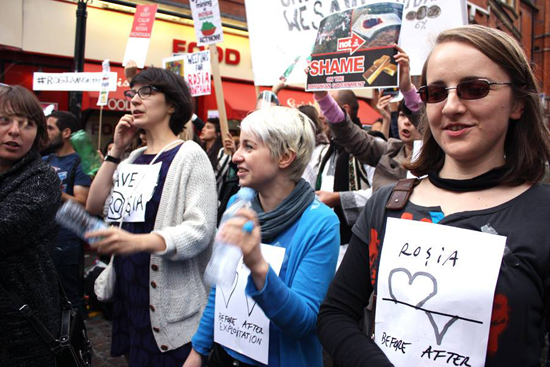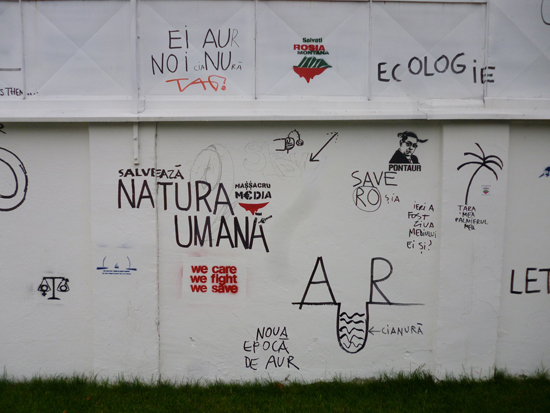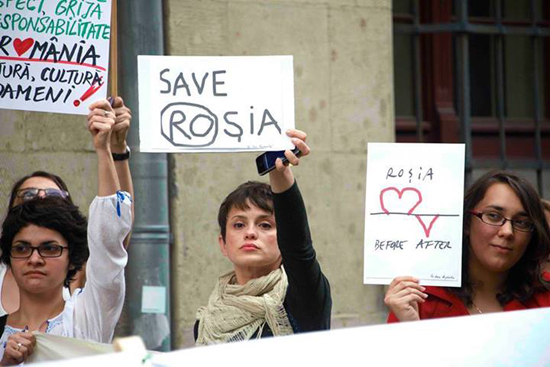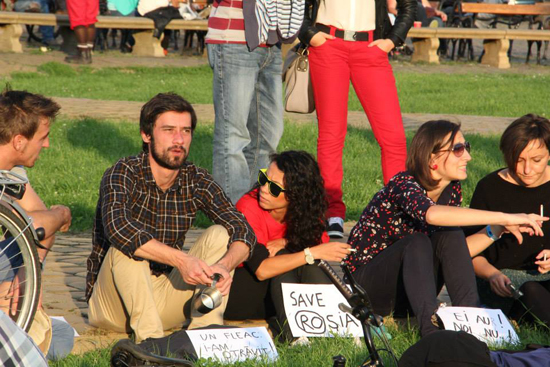Interview with Dan Perjovschi

I spoke with Dan Perjovschi, one of the most internationally respected artists living in Romania, about his political activities against the Rosia Montana cyanide gold mining project (headed by Gabriel Resources, a Canadian corporation). On August 27, 2013, a law was passed in a closed-door session of parliament to go forward with the project despite fifteen years of debate and opposition. In response and starting on September 1, protests against this law, the project, and the corruption linked to this project have erupted around the country and internationally, with tens of thousands of people from different political backgrounds (including progressive and nationalist) galvanized into action. The demands of the protesters are that the law be rescinded and that the ministers responsible for pushing it forward and accepting payment from Gabriel Resources be fired. Perjovshi made several drawings with short but powerful statements that communicate and represent the sentiments of the protest-movement.
Olga Stefan: What do you think brings all these protesters together as a unified front against this particular initiative, while other protests against political corruption, and what was called a coup in 2012, have not had the same force?
Dan Perjovschi: In only one year, the current government (considered center left and brought into power after the protests in 2012) managed to do everything possible to piss people off. I was also involved in student Occupy movements in both Cluj and Bucharest in March. The students’ requests were legitimate – they asked for space for debate and a committed budget. The government totally ignored this. Then, when this law custom-made for a corporation was given the greenlight, young people went to the streets. The core group of the protesters are activists who have been fighting this project for fifteen years. I also think the theme is precise enough (stop the cyanide in Rosia Montana) and universal enough (the protection of nature and our country, and against corporations) to unite yuppies, anti-capitalists, anarchists, artists, bike lovers, etc.
OS: As an artist you have always been politically engaged and have made work that has criticized specific issues through the use of irony and humor. One can say that current events are the material out of which you make your work. Recently, you have devoted your activism to the Rosia Montana cause by posting drawings specific to this issue on your Facebook page (which is followed by thousands) and sharing documentation of the protests from various parts of the world. What impact have you had and is it realistic to think that artists, in general, can impact political events through their artwork?
 DP: For some time, I have been sliding from the institutional wall to the walls of Facebook. I found it to be an interesting space. Here, my drawings mean something beyond “art.” I can have a more objective and precise look at the events I comment on. During the student Occupy protest, Iposted a drawing and if somebody on the ground identified with it, he/she could use it. The students downloaded them and put them all around the amphitheater they occupied. It was one of my best “shows.” Now with Rosia Montana, I also deliver some statements on Facebook to help people focus on the issues. They replicate them on big banners or download them and stick them on their t-shirts. Excellent! I really feel I have a role. I am not on the frontlines (this is not my revolution), but I can support and show some solidarity with this new generation. In January 2012, the protest was quickly politically manipulated. This time, Rosia Montana Gold Corporation (Gabriel Resources) bought almost all of the media; so, at first, they turned a blind eye. Then when social media took the news and spread it, the old media had to report on it. They tried to throw dirt at the protesters, but it did not stick. The protesters outsmarted their “power” by using bikes to move around with, drumming on plastic bottles in the big boulevards, and keeping everything peaceful and creative to psychologically unarm the police.
DP: For some time, I have been sliding from the institutional wall to the walls of Facebook. I found it to be an interesting space. Here, my drawings mean something beyond “art.” I can have a more objective and precise look at the events I comment on. During the student Occupy protest, Iposted a drawing and if somebody on the ground identified with it, he/she could use it. The students downloaded them and put them all around the amphitheater they occupied. It was one of my best “shows.” Now with Rosia Montana, I also deliver some statements on Facebook to help people focus on the issues. They replicate them on big banners or download them and stick them on their t-shirts. Excellent! I really feel I have a role. I am not on the frontlines (this is not my revolution), but I can support and show some solidarity with this new generation. In January 2012, the protest was quickly politically manipulated. This time, Rosia Montana Gold Corporation (Gabriel Resources) bought almost all of the media; so, at first, they turned a blind eye. Then when social media took the news and spread it, the old media had to report on it. They tried to throw dirt at the protesters, but it did not stick. The protesters outsmarted their “power” by using bikes to move around with, drumming on plastic bottles in the big boulevards, and keeping everything peaceful and creative to psychologically unarm the police.
OS: How do you deal with copyright issues, or do you prefer the “copyleft” approach? How does your distribution model affect your practice?
DP: For these protests, it’s “copyleft,” but only for activist and communication purposes. However, if I see somebody selling a t-shirt (with my images), I will sue them. All rights for the drawings on this topic are for the association Alburnus Maior, located in Rosia Montana and who has been fighting the BIG company since 2000.
OS: The majority of funding for culture and the arts in Romania is foreign and has not been contested by the cultural community. Why, then, do you think that slogans about “foreigners” stealing Romanian gold have appeared now? Do you feel this fear of the foreigner is reasonable in our globalized economic system? And why do you feel that this anti-foreigner sentiment is coming out in this context more than in other infrastructure projects?
 DP: These kinds of slogans are marginal, and are more against the idea of a super powerful corporation who can buy a town and some mountains then do whatever they like with them. The protesters are very mixed. Some are very nationalist people (“Romania above all, the rest of the world is against us”), but there are also youngsters who discover the joy of being “Romanian” and being among “the people.” There are a lot of flags at the protests. I am not necessarily very happy with this section, especially with people wearing tri-color bands on their foreheads (there was a recent very nationalist episode symbolized by this tri-color band), but I accept the fact that some of the people find a motif that makes them feel proud of being Romanian. It’s been a long time with only bad news about ourselves.
DP: These kinds of slogans are marginal, and are more against the idea of a super powerful corporation who can buy a town and some mountains then do whatever they like with them. The protesters are very mixed. Some are very nationalist people (“Romania above all, the rest of the world is against us”), but there are also youngsters who discover the joy of being “Romanian” and being among “the people.” There are a lot of flags at the protests. I am not necessarily very happy with this section, especially with people wearing tri-color bands on their foreheads (there was a recent very nationalist episode symbolized by this tri-color band), but I accept the fact that some of the people find a motif that makes them feel proud of being Romanian. It’s been a long time with only bad news about ourselves.
Artists are more visible sometimes in these protests due to their smart, well-designed protest signs, but they are a minority. See, my generation was fighting communism (even after communism was theoretically gone) and this new generation criticizes capitalism because this is what they experience and live every day. This attitude may sadden or infuriate their parents and grandparents but it is true and valid. Where I see residue of communism and practices of camouflage, they see neoliberalism and the society for the few and not for the all. They have all the right in the world to be critical about what society we, of the previous generation, prepared for them. The majority of protesters are young professionals, people with jobs in the liberal economy, working at home or even in multinationals — people with a safe income. They are not against”capitalism” per se (as some of the artists or extreme left activists are, some displaying very stupid Maoist slogans), but are against corruption, against the weak state and the official ignorance of the state of law. They are arguing that no one (a company, the government, the president) is above the law. But there is a general discontent with the way Romanian capitalism is going. There is a mistrust of foreign companies who come to bribe officials to do their stuff, then relocate to Africa and leave behind some disaster. There is the same opaque policy implemented by the government and big private companies who prefer making their deals behind closed doors. People have had enough of this.
OS: There have also been some discussions that George Soros (who also had a large stake in Gabriel Resources but also invested substantially in Romanian NGOs and culture) is a conspirator in the Rosia Montana project, despite donating money to organizations that oppose the project. What do you make of these accusations?
DP: It seems Soros has some stocks or is involved in an investment fund that has stocks. I do not care. Since 1990, every time there is a protest in this country, there are accusations that some Hungarian or Jew is behind it. I am so sick of seeing the same trick apply to me twenty-three years later (we have being accused of being paid by bloody capitalists). Romanians are very skilful at passing the blame onto others and they love conspiracy theories. Romania itself is a conspiracy theory.
OS: What are some alternatives to the mining proposal pushed forward so aggressively by Gabriel Resources? What options for jobs do the people in that region have, many who complain that they have been unemployed for more than a decade since negotiations over the project began and mining stopped? They feel that the government and others who protest in their name don’t seem to consider their fate.
 DP: The mining at Rosia Montana stopped in 2006. Before that, it had stopped here and there and everywhere because it was not economically viable due to old technology and bad management. In Romania, the communist and post-communist governments used miners as a force-based argument (an undercover paramilitary force). They were paid triple by the communists, or even more, the wage of a normal worker. It is a hard, high-risk job, but it was also a political decision. In time, these privileges decreased dramatically. When mines were closed, miners got a payoff of ten salaries (which is a huge sum). But they spent the money, and because there was no other governmental plan the situation got nightmarish. But in a sense they took the deal.
DP: The mining at Rosia Montana stopped in 2006. Before that, it had stopped here and there and everywhere because it was not economically viable due to old technology and bad management. In Romania, the communist and post-communist governments used miners as a force-based argument (an undercover paramilitary force). They were paid triple by the communists, or even more, the wage of a normal worker. It is a hard, high-risk job, but it was also a political decision. In time, these privileges decreased dramatically. When mines were closed, miners got a payoff of ten salaries (which is a huge sum). But they spent the money, and because there was no other governmental plan the situation got nightmarish. But in a sense they took the deal.
There are villages and towns in the Apuseni mountains that don’t live off of mining. Some successfully transitioned to new industries (wood, tourism, mountain agriculture). But Gabriel Resources forced the local authority to pass a law declaring the area mono-industrial (only mining), therefore if you want to open a small hotel or cultivate bees you cannot. This is unacceptable. I read proposals made by a very serious institution recommending that the region should be declared a mining park (some of the tunnels date to 2,000 years ago and to the Roman Empire), and get money from the European Union to support this. It sounds very reasonable. I was in Rosia Montana on the occasion of a new music festival (which turned into a camp for activism and workshops called Fan Fest (or in Romanian Hay Fest). Several thousand youngsters from all over Europe came. Also, there is a prestigious architecture summer school nearby where young architects learn to properly restore houses that are 200 years old. One could, for example,turn the area (which is truly beautiful) into a grand school about mining, architecture and nature.
OS: How do you feel about Facebook’s copyright policies regarding posted images and putting your drawings, which in other contexts are original art, in a space where the copyright no longer belongs to you?
DP: I do not know the policy of Facebook. But I do not post everything I do. And the drawings I did about Rosia Montana I declared “copyleft” so everybody could use them noncommercially. I think we exaggerate the issue of copyright. It no longer belongs to me entirely, I share the copyright with Facebook. I will use my images and my drawings in my future projects and I will just wait for Mr. Zuckerberg (the owner of Facebook) to sue me and make me globally famous. I don’t feel comfortable with this, but is it not the same when some photographer photographs my wall and that becomes “his” work? I think it is kind of funny for me to ask him permission to use images of my drawings. I tell anyone who owns a work of mine that he/she owns a hard-copy version of the drawing because the drawing is a concept I will keep using over and over until I die.
OS: Has your work on behalf of various causes and the dissemination of your drawings through Facebook increased awareness of your artistic practice?
DP: I have no idea if it matters more for other people. But it matters to me. Somehow my drawings found a new and more truthful life. There is something very artificial about the white cube. I want my drawings to be free and active. If people identify with them, I am so very happy.
OS: Some of the drawings you made for Rosia Montana have been used in the protests and have been photographed and shared online, making them the most recognizable feature of the protests besides the Romanian flag. What do you think about the possibility of your drawings becoming the “logo” for the protests?
 DP: I have a contribution (which is more interesting to people abroad), but it is not my graphics that dominate the visual discourse of the protests. It is the red-green logo of the campaign made by some good artists and designers from Cluj and the association from Rosia Montana itself. It is the slogan “United will save”… There are also people with texts and big banners who are the “face” of the protest. My drawings are appealing to “intellectuals,” “arty” types, or maybe to “clever” people, but not so directly to the masses. But I am happy with the place they occupy here and there. I think it is a big deal to bridge high and low culture. Years ago in order to criticize me, an article in The New York Times stated that my mural at the Museum of Modern Art (MOMA) was a crowd pleaser. I was not offended. I was pleased. I can show the same drawing at MOMA, the Tate Modern, the Georges Pompidou Center or in the middle of a protest in Gesi Park or Piata Universitatii in Bucharest. Isn’t this splendid?
DP: I have a contribution (which is more interesting to people abroad), but it is not my graphics that dominate the visual discourse of the protests. It is the red-green logo of the campaign made by some good artists and designers from Cluj and the association from Rosia Montana itself. It is the slogan “United will save”… There are also people with texts and big banners who are the “face” of the protest. My drawings are appealing to “intellectuals,” “arty” types, or maybe to “clever” people, but not so directly to the masses. But I am happy with the place they occupy here and there. I think it is a big deal to bridge high and low culture. Years ago in order to criticize me, an article in The New York Times stated that my mural at the Museum of Modern Art (MOMA) was a crowd pleaser. I was not offended. I was pleased. I can show the same drawing at MOMA, the Tate Modern, the Georges Pompidou Center or in the middle of a protest in Gesi Park or Piata Universitatii in Bucharest. Isn’t this splendid?
OS: I find your political debates and discussions on Facebook really interesting. This is something that doesn’t happen much in the United States or other parts of Western Europe. Why do you think your Romanian “friends” use Facebook in such a meaningful way?
DP: Maybe because in Romania, we do not have a “public space.” We did not have places to meet and talk and argue. Maybe the wind of the Arab Spring came to us in this autumn. We are part of this broader change. Media is going online. Shopping is going online. Political debates are going online. Everything is going online. These protests are the first sizeable protest since the 1990s.
OS: What do you think will happen with the mining project and the current government that has accepted bribes from Gabriel Resources to push the project forward? From previous experience, one bad government was replaced by another equally bad or worse government. Is this the future here, too?
DP: I think the current government won’t do it. But if they pass the law there will be extreme protests and violence. And then you do not know where this will go. There are people in the Rosia Montana region who do not want to sell their houses and do not want to move. They are capable of ultimate resistance. People have had it with this government and are just waiting for the occasion to express their anger. I really do not think it is worth it to erase four mountains, to displace hundreds of people, and enrage the young generation just to place twenty tons of gold in the National Bank Reserve. It is not worth it!





